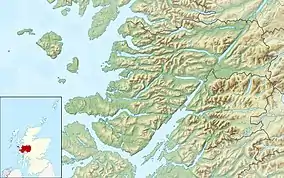Loch Sunart
Loch Sunart (Scottish Gaelic Loch Shuaineart) is a sea loch on the west coast of Scotland. Loch Sunart is bounded to the north by the Sunart district of Ardnamurchan and to the south by the Morvern district. At 31 kilometres (19 mi) it is the longest sea loch in the Highland local government area. The maximum depth of the loch is 124 metres east of Càrna near the entrance to Loch Teacuis. Other islands in the loch include Oronsay, seaward of Càrna, Risga, which lies between the two larger islands, and Eilean Mòr, which lies towards the landward end of the loch in line with Beinn Resipol.

| Loch Sunart MPA | |
|---|---|
IUCN category IV (habitat/species management area) | |
 Looking south over Loch Sunart to Morvern | |
 The location of Loch Sunart, in Lochaber | |
| Location | Lochaber, Scotland |
| Coordinates | 56.7001°N 5.7569°W |
| Area | 4,900 ha (19 sq mi)[1] |
| Designation | Scottish Government |
| Established | 2014 |
| Operator | Marine Scotland |
A considerable part of the loch is leased for aquaculture, with fish farming, originally only of salmon but now somewhat diversified, being established in the 1980s.
A local legend holds that the absence of resident swans in Loch Sunart is the result of a doomed love affair between a Celtic chieftain and a local girl. When his mother, who opposed a marriage, turned her into a swan to thwart their love, the young man accidentally killed the swan while hunting. On learning of the swan's real identity he killed himself to join the swan at the bottom of the loch, which swans supposedly have shunned ever since.[2]
In 2014 the entire loch (an area of 4,900 hectares (49 km2)) was declared a Nature Conservation Marine Protected Area (NCMPA), to protect features including flame shell beds and Leptometra celtica population.[1] Serpulid beds are also present here, as are organisms such as sponges, starfish and brittlestars.[3] The MPA is designated a Category IV protected area by the International Union for Conservation of Nature.[4] Within the MPA the use of fishing gear is generally prohibited, although creeling is permitted in certain parts of the loch.[5]
The loch also forms part of a larger (74,100 hectares (741 km2)) NCMPA, entitled Loch Sunart to the Sound of Jura, which extends to include the Sound of Mull, the Firth of Lorne and the Sound of Jura. This MPA has been designated to protect the population of common skate and the area's quaternary geological features.[6]
References
- "Loch Sunart MPA(NC)". NatureScot. Retrieved 11 October 2020.
- Woodward, Jennifer; Kingshill, Sophia (2012). The Lore of Scotland: A guide to Scottish legends. Random House.
- "Loch Sunart Marine Protected Area Site Summary". Scottish Government. Retrieved 11 October 2020.
- "Loch Sunart in United Kingdom of Great Britain and Northern Ireland". Protected Planet. Retrieved 25 October 2019.
- "Scottish Statutory Instrument 2015 No. 435: The Inshore Fishing (Prohibition of Fishing and Fishing Methods) (Scotland) Order 2015". Queen’s Printer for Scotland. 16 December 2015. Retrieved 25 October 2019.
- "Loch Sunart to the Sound of Jura MPA(NC)". NatureScot. Retrieved 11 October 2020.
External link
- Loch Sunart at The Gazetteer for Scotland
- Loch Sunart Aquaculture Framework Plan (Highland council report)
- Loch Sunart Marine Protected Area Site summary leaflet - Scottish Government
| Wikimedia Commons has media related to Loch Sunart. |